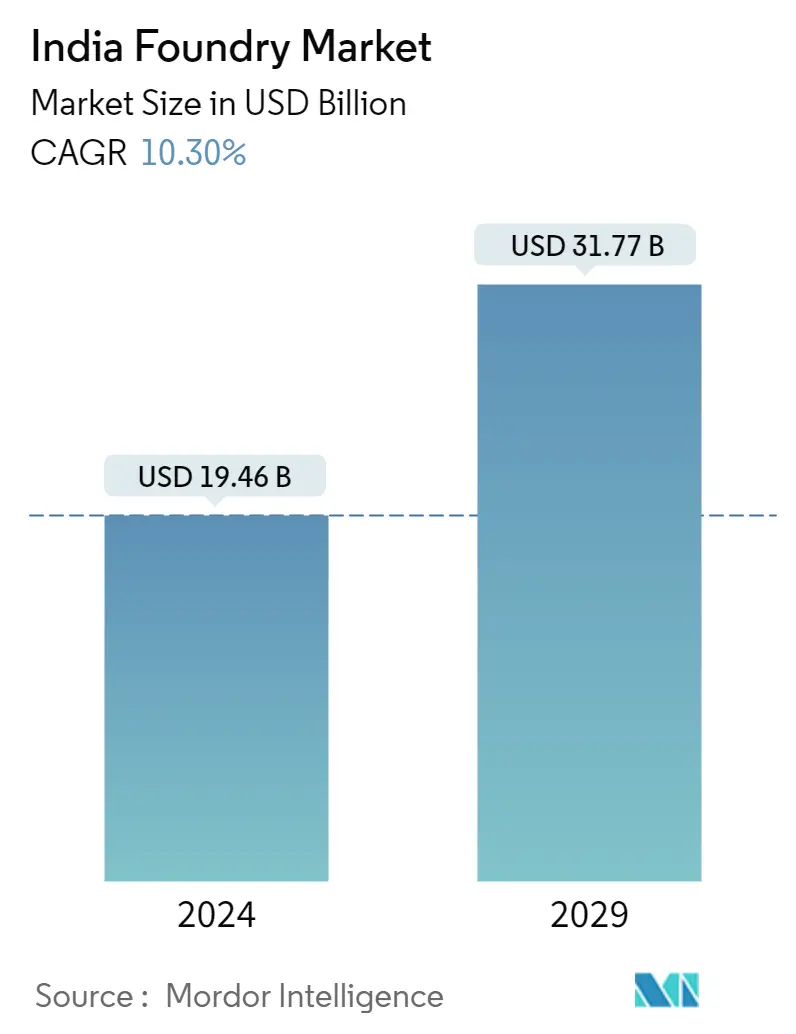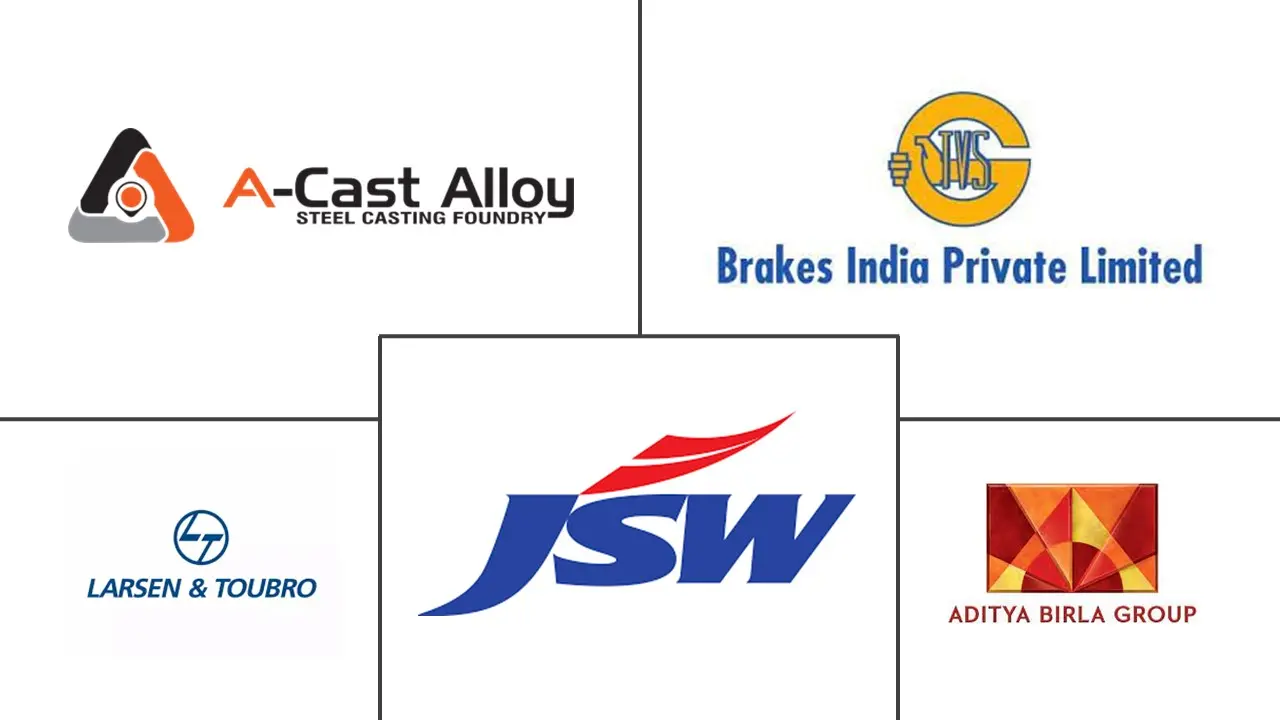Market Size of India Foundry Industry

| Study Period | 2020 - 2029 |
| Base Year For Estimation | 2023 |
| Market Size (2024) | USD 19.46 Billion |
| Market Size (2029) | USD 31.77 Billion |
| CAGR (2024 - 2029) | 10.30 % |
| Market Concentration | Low |
Major Players
*Disclaimer: Major Players sorted in no particular order |
India Foundry Market Analysis
The India Foundry Market size is estimated at USD 19.46 billion in 2024, and is expected to reach USD 31.77 billion by 2029, growing at a CAGR of 10.30% during the forecast period (2024-2029).
During the COVID-19 pandemic in December 2020, more than 400 small foundries in Coimbatore shut their doors due to rising raw material prices. The shutdown affected lakhs of employees working in and with the foundries, as well as in other industries such as pumps, textile machines, automobiles, and other engineering sectors. Moreover, in March 2022, several foundry units in Kolhapur were temporarily closed and declared three to four days of holiday for their employees due to a sharp increase in raw material prices caused by the Russia-Ukraine war.
- The major foundry clusters in India are located in Batala, Jalandhar, Ludhiana, Agra, Pune, Kolhapur, Sholapur, Rajkot, Mumbai, Ahmedabad, Belgaum, Coimbatore, Chennai, Hyderabad, Howrah, Kolkata, Indore, Faridabad, and Gurgaon. Typically, each foundry cluster is known for catering to some specific end-use markets. For example, the Coimbatore cluster is famous for pump-set castings, the Kolhapur and Belgaum clusters for automotive castings, the Rajkot cluster for diesel engine castings, and the Howrah cluster for sanitary castings. The IIF estimates suggest that there are over 7,000 foundry units in the country, with about 3,000 located in Gujarat. The sector provides direct employment to about five lakh people and indirect employment to 15 lakh people.
- Moreover, the focus on technology upgrades notably drives the growth of the Indian foundry market. For instance, in India, many foundries use cupolas using LAM Coke. However, these are gradually shifting to Induction Melting. There is growing awareness about the environment, and many foundries are switching over to induction furnaces, while some units in Agra are changing over to cokeless cupolas. However, the major challenges faced in India include a lack of skilled manpower, adequate power supply at competitive rates, availability due to mining and environmental issues, and the short-term slowdown in demand, which may hinder medium and longer-term investments.
India Foundry Industry Segmentation
A foundry is a factory where castings are produced by melting the metal, pouring the liquid into a mold, and allowing it to cool and solidify into the desired shape. Foundries are one of the most significant contributors to the manufacturing recycling movement, melting and recasting millions of tons of scrap metal every year to create new, durable products. Moreover, many foundries use sand in their molding process. These foundries often use, recondition, and reuse sand, which is another form of recycling.
The India foundry market is segmented by end-user (automotive, electrical and construction, industrial machinery, and other end -users) and by type (gray iron casting, non-ferrous casting, ductile iron casting, steel casting, and malleable casting).
The India foundry market report offers the market size and forecast value in (USD) for all the above segments.
| By End-user | |
| Automotive | |
| Electrical and Construction | |
| Industrial Machinery | |
| Other End-Users |
| By Type | |
| Gray Iron Casting | |
| Non-ferrous Casting | |
| Ductile Iron Casting | |
| Steel Casting | |
| Malleable Casting |
India Foundry Market Size Summary
The Indian foundry market is poised for significant growth, driven by rapid industrialization, urbanization, and a booming automobile manufacturing sector. The market is characterized by a diverse range of foundry clusters across the country, each specializing in specific end-use markets such as automotive, diesel engine, and sanitary castings. The sector is a major source of employment, providing direct and indirect jobs to a substantial number of people, particularly in socially and economically disadvantaged areas. The market's expansion is further supported by government initiatives and increased infrastructure spending, which boost demand for machinery and equipment requiring metal castings. Foundries are investing in technological upgrades, such as shifting from cupolas to induction melting, to enhance productivity and meet the growing demand for metal castings.
Despite challenges like rising raw material costs and a shortage of skilled manpower, the Indian foundry market is expected to experience robust growth. The market is highly fragmented and competitive, with major players employing strategies like mergers, acquisitions, and geographical expansion to maintain their market position. The sector's growth is also fueled by the MSME segment, which plays a crucial role in the foundry industry, supported by government policies and financial disbursements. As the market continues to evolve, the focus on sustainability and reducing carbon footprints is becoming increasingly important, with companies exploring green casting solutions. Overall, the Indian foundry market is set to expand significantly, driven by technological advancements, increased demand from the automotive industry, and supportive government policies.
India Foundry Market Size - Table of Contents
-
1. MARKET INSIGHTS AND DYNAMICS
-
1.1 Market Overview
-
1.2 Market Dynamics
-
1.2.1 Drivers
-
1.2.1.1 Increasing Focus on Technology Upgrades
-
1.2.1.2 Formation of Foundry Clusters
-
-
1.2.2 Restraints
-
1.2.2.1 Stringent Government Regulations
-
1.2.2.2 Lack of Highly Skilled Manpower
-
-
1.2.3 Oppurtunities
-
1.2.3.1 Increasing focus on Sustainability
-
1.2.3.2 Growing Government Expenditure
-
-
-
1.3 Technologies Employed in Foundry Industry
-
1.4 Potential foundry Clusters in India
-
1.5 Value Chain/Supply Chain Analysis
-
1.6 Industry Attractiveness- Porter's Five Forces Analysis
-
1.6.1 Bargaining Power of Suppliers
-
1.6.2 Bargaining Power of Consumers
-
1.6.3 Threat of New Entrants
-
1.6.4 Threat of Substitutes
-
1.6.5 Intensity of Competitive Rivalry
-
-
1.7 Impact of COVID-19 on the Market
-
-
2. MARKET SEGMENTATION
-
2.1 By End-user
-
2.1.1 Automotive
-
2.1.2 Electrical and Construction
-
2.1.3 Industrial Machinery
-
2.1.4 Other End-Users
-
-
2.2 By Type
-
2.2.1 Gray Iron Casting
-
2.2.2 Non-ferrous Casting
-
2.2.3 Ductile Iron Casting
-
2.2.4 Steel Casting
-
2.2.5 Malleable Casting
-
-
India Foundry Market Size FAQs
How big is the India Foundry Market?
The India Foundry Market size is expected to reach USD 19.46 billion in 2024 and grow at a CAGR of 10.30% to reach USD 31.77 billion by 2029.
What is the current India Foundry Market size?
In 2024, the India Foundry Market size is expected to reach USD 19.46 billion.

